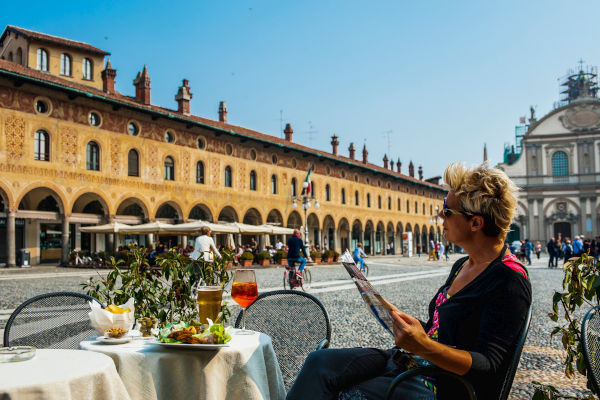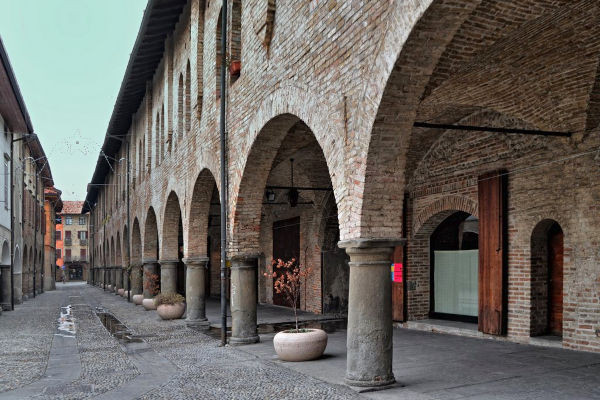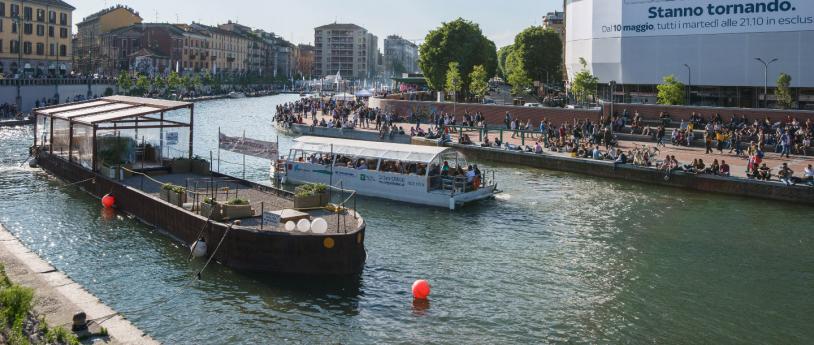- Lifestyle
- Art & Culture
Discovering the most beautiful arcades and galleries in Lombardy
Sheltered walkways for shopping, drinking a coffee or an aperitif in an elegant bar, arcades and galleries are the living rooms of many Lombardian historical centers.
To discover their origins, we must go back to Hellenistic Greek architecture that first inspired the Romans, then the peoples of Europe. Let's take a virtual tour of some of the most beautiful arcades and galleries in Lombardian cities and towns: from the nineteenth-century urban arcades, to the elegant arches of Renaissance palaces, to medieval covered passages transformed into open-air markets...
An exclusive café, under the arcades of Piazza del Duomo in Milan
The arcades of the Piazza del Duomo in Milan, which mark the boundary of the cathedral's large square, are the largest in Italy. A long corridor with a marble floor, where you can stroll, admire elegant shop windows, such as those from the Rinascente, stop for a coffee or an aperitif in historic places, such as the Caffè Camparino. We are in the “living room of Milan” where bourgeois and flâneur types spent leisurely afternoons, now dedicated to shopping. The late 19th century arcades are the work of the architect Giuseppe Mengoni, such as the Galleria Vittorio Emanuele II - which connects the Duomo to the Scala - another magnificent example of passage architecture.
Brescia: walking along the arcades of Piazza della Loggia
Bordered by sixteenth-century buildings, the Piazza Loggia - in the heart of Brescia - is surrounded by sheltered arcades, perfect for a stroll dedicated to shopping and relaxation. The long Renaissance portico of Piazza Loggia, with single spans made of white Botticino stone, is the work of the architect Piero Maria Bagnadore and follows in the lower part of the building that incorporates the Clock Tower (1550), continuing along via Dieci Giornate and Corso Zanardelli. And if you are delayed in spending, the Macc de le ure, the two automata of the mechanical clocks by Paolo Gennari da Rezzato (1546), will take care of calling out the time.
The Renaissance arcade in the square-living room of Vigevano
In the center of Vigevano (Pavia), Piazza Ducale - a jewel of Renaissance architecture (1492) - is the "birthday present" to Ludovico il Moro, who was born there in 1452. The large space in front of the ducal residence of the ancient castle owes its beauty to Leonardo and Bramante. Piazza Ducale is surrounded on 3 sides by arcaded porticos, supported by 84 serizzo columns with worked capitals. On the main floor there are arched windows, oculi on the upper floor. The façades are painted with trompe l'oeil architectural motifs. Under the arcades, the ancient shops and inns have now become elegant shops and places to sit and admire the splendid Baroque facade of the Duomo.
Back in time, among the medieval arcades of the lower Bergamo area
The medieval arcades of Romano di Lombardia and Martinengo, extensive and well preserved, are perhaps the most beautiful of those found in the lower Bergamo area. In Romano di Lombardia, in the historic center, the Portici della Misericordia - commissioned by Bartolomeo Colleoni together with the palace of the same name (1475) - have round arches resting on capitals, massive columns and stone bases. Their name derives from the presence of lodgings for the poorest residents, right above the 16 shops on the ground floor (one for each span). The town's commercial activities have always taken place under these arcades, as evidenced by the Roman marble slab used in the Middle Ages as a fish counter, just below the Palazzo della Ragione.
Other fifteenth-century arcades in the medieval village of Martinengo testify to the activity of shopkeepers. With protected external extensions of the shops to display goods on the stalls, according to rigid divisions that are still visible on the pavement, these arcades enjoyed their moment of fame by appearing in Ermanno Olmi's film L’albero degli zoccoli.
Sabbioneta: the arcade of the Gallery of the Ancients
In the rooms of the Palazzo Giardino (1587) and in the Galleria degli Antichi di Sabbioneta (MN), the Duke Vespasiano Gonzaga Colonna kept his rich archaeological collection. The Galleria or Corridor Grande in the Piazza del Castello is a long and narrow building, in exposed stone, consisting of a 97 m long pedestrian arcade, with cross vaults and 26 spectacular round arches, separated by pillars. The external appearance is reminiscent of a Roman aqueduct and the great charm of this place survives, despite the fact that Vespasiano's collections now resides in Mantua, in the Palazzo Ducale and in the Palazzo di S. Sebastiano.































